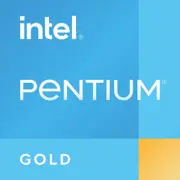Intel Pentium Gold G5400

Intel Pentium Gold G5400: processore economico per compiti di base nel 2025
Panoramica delle possibilità, compatibilità e scenari d'uso
Caratteristiche principali: Coffee Lake in miniatura
Il processore Intel Pentium Gold G5400, rilasciato nel 2018, rimane ancora rilevante per le configurazioni economiche grazie alla sua efficienza energetica e al prezzo accessibile (circa $70 nel 2025).
Architettura e processo tecnologico
- Nome in codice: Coffee Lake (14 nm).
- Core/Threads: 2 core, 4 threads (Hyper-Threading).
- Cache: 4 MB L3.
- Frequenza di base: 3.7 GHz (senza Turbo Boost).
Nonostante il processo tecnologico di 14 nm sia datato, il processore dimostra di avere prestazioni stabili in compiti d'ufficio e applicazioni leggere. La grafica integrata Intel UHD Graphics 610 supporta video 4K (tramite HDMI 1.4) e gaming di base.
Prestazioni
- Geekbench 6: 730 (monocore), 1508 (multicore).
- Esempi pratici:
- Riproduzione di YouTube in 4K: utilizzo della CPU al 20-30%.
- CS:GO a impostazioni basse: 40-50 FPS (720p).
- Lavoro in Microsoft Office: reattività immediata.
Caratteristiche chiave: supporto per virtualizzazione (VT-x), crittografia hardware dei dati (AES-NI), consumo energetico inferiore a 60 W.
Schede madri compatibili: socket LGA 1151v2
Per il Pentium G5400 sono compatibili le schede madri con chipset H310, B360, H370, Z370, Z390.
Raccomandazioni per la scelta
- Opzione economica: ASUS Prime H310M-K (circa $60). Supporto per DDR4-2666, HDMI, USB 3.1.
- Per upgrade: MSI B360M Pro-VDH ($80-90). Include M.2 per NVMe SSD e quattro slot per RAM.
Importante:
- Il socket LGA 1151v2 non è compatibile con i processori di ottava generazione su schede madri più vecchie (ad esempio, H110).
- Potrebbe essere necessario un aggiornamento del BIOS per i chipset Z370/Z390.
Memoria: DDR4-2400 e modalità dual-channel
- Tipo di memoria: DDR4-2133/2400 (supporto ufficiale).
- Capacità massima: 64 GB (nella pratica fino a 32 GB a causa dei limiti delle schede madri economiche).
- Raccomandazioni:
- 2×8 GB DDR4-2400 (ad esempio, Kingston ValueRAM — $35 per il kit).
- Evitare moduli ad alta frequenza (superiori a 2666 MHz) — il processore non li utilizza.
Consiglio: Attivare la modalità dual-channel per un aumento delle prestazioni nei giochi dal 10 al 15%.
Alimentatore: minimo 300 W
Con un TDP di 58 W, il processore non richiede un alimentatore potente:
- Senza scheda video dedicata: 300 W (ad esempio, EVGA 400W — $40).
- Con scheda video di livello GTX 1650: 450 W (Corsair CX450 — $60).
Criteri di scelta:
- Certificazione 80 Plus Bronze.
- Connettore 4-pin CPU (alcuni alimentatori economici non lo hanno).
Pro e contro del Pentium G5400
Vantaggi:
- Prezzo: Uno dei processori più accessibili con Hyper-Threading.
- Efficienza energetica: Adatto per PC compatti e HTPC.
- Grafica UHD 610: Capace di gestire Netflix in 4K e giochi vecchi.
Svantaggi:
- 2 core: Multitasking limitato (ad esempio, streaming + gioco non è un'opzione).
- Nessun overclock: Frequenza fissa.
- Piattaforma datata: Nessun supporto per PCIe 4.0 e DDR5.
Scenari d'uso
1. Ufficio e studio
- Esempio: Lavoro con documenti, conferenze Zoom, browser (10+ schede aperte).
- Raccomandazioni: Aggiungere un SSD (ad esempio, Kingston A400 240 GB — $25).
2. Multimedia
- Esempio: Media center basato su Mini-ITX (riproduzione 4K tramite Plex).
- Raccomandazioni: Usare raffreddamento passivo (Noctua NH-L9i).
3. Gaming leggero
- Esempio: Dota 2, Minecraft, Overwatch (con impostazioni basse).
- Consiglio: Aggiungere una scheda video di livello GTX 1050 Ti (usata — $80).
Confronto con i concorrenti
AMD Athlon 3000G (prezzo: ~$65)
- Pro: Grafica Vega 3 più potente della UHD 610.
- Contro: Nessun Hyper-Threading, IPC inferiore.
Intel Celeron G5905 (prezzo: ~$50)
- Pro: Più economico.
- Contro: 2 core/2 thread, meno efficace nel multitasking.
Conclusione: Il Pentium G5400 supera il Celeron grazie all'Hyper-Threading, ma è inferiore all’Athlon in termini di grafica.
Consigli pratici per l'assemblaggio
1. SSD obbligatorio: Un HDD "strozzerebbe" anche questa CPU.
2. Cooler: Quello di serie va bene, ma per un funzionamento silenzioso prendi un Deepcool GAMMAXX 400 ($20).
3. Scheda madre: Scegli modelli con HDMI 2.0, se necessario 4K@60 Hz.
4. Upgrade: In futuro è possibile installare un Core i3-9100 (4 core/4 thread), ma è meglio considerare subito la piattaforma LGA 1200.
Conclusione: a chi si adatta il Pentium G5400 nel 2025?
Questo processore è una scelta per:
- PC da ufficio economici.
- Media center domestici.
- Studenti che hanno bisogno di un computer per lo studio.
Perché proprio lui? Prezzo basso, prestazioni sufficienti per compiti di base e consumo energetico minimo. Tuttavia, per giochi o compiti professionali è meglio aggiungere $50-100 e optare per un Ryzen 3 5300G o un Core i3-12100.
Conclusione: Il Pentium G5400 è un "lavoratore instancabile" per chi non è disposto a pagare in più per prestazioni eccessive.
Di base
Specifiche della CPU
Specifiche della memoria
Specifiche della GPU
Varie
Classifiche
Rispetto ad altre CPU
Condividi sui social media
Oppure linkaci
<a href="https://cputronic.com/it/cpu/intel-pentium-gold-g5400" target="_blank">Intel Pentium Gold G5400</a>